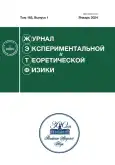NANOCRYSTAL SHAPE ANISOTROPY DETERMINATION USING EXAFS
- Autores: Svit K.A.1, Zhuravlev K.S.1
-
Afiliações:
- Rzhanov institute of semiconductor physics, Siberian Branch of the Russian Academy of Sciences
- Edição: Volume 165, Nº 1 (2024)
- Páginas: 65-72
- Seção: Articles
- URL: https://journal-vniispk.ru/0044-4510/article/view/256898
- DOI: https://doi.org/10.31857/S0044451024010073
- ID: 256898
Citar
Resumo
Using the set of the nanocrystals (NC) having the rectangular parallelepiped shape and a cubic crystal structure of the zinc-blende type as model system, the possibilities of determining the NC shape anisotropy using the polarized EXAFS technique were demonstrated. It was shown that the effective value of the coordination number of absorbing atoms in an NC with anisotropic shape depends on its size and the orientation of the X-ray radiation polarization vector relative to the NC surface. The effective values of the coordination numbers of the first coordination sphere of atoms in NCs having different size and surface composition were modeled. Taking into account the influence of the experimental error of the EXAFS method the possibilities of the model applicability for analysis of the real systems with NC were analyzed.
Palavras-chave
Sobre autores
K. Svit
Rzhanov institute of semiconductor physics, Siberian Branch of the Russian Academy of Sciences
Autor responsável pela correspondência
Email: svitkirill1989@gmail.com
Rússia, 630090, Novosibirsk
K. Zhuravlev
Rzhanov institute of semiconductor physics, Siberian Branch of the Russian Academy of Sciences
Email: svitkirill1989@gmail.com
Rússia, 630090, Novosibirsk
Bibliografia
- M. A. Cotta, ACS Appl. Nano Mater. 3, 4920 (2020).
- D. S. Abramkin and V. V. Atuchin, Nanomaterials12, 3794 (2022).
- W. C. Chao, T. H. Chiang, Y. C. Liu, Z. X. Huang,C. C. Liao, C. H. Chu, C. H. Wang, H. W. Tseng, W. Y. Hung, and P. T. Chou, Commun. Mater. 2, 96 (2021).
- Al. L. Efros, M. Rosen, M. Kuno, M. Nirmal,D. J. Norris, and M. Bawendi, Phys. Rev. B 54, 4843 (1996).
- E. S. Smotkin, C. Lee, A. J. Bard, A. Campion,M. A. Fox, T. E. Mallouk, S. E. Webber, and J. M. White, Chem. Phys. Lett. 152, 265 (1988).
- J. J. Shiang, S. H. Risbud, and A. P. Alivisatos, J. Chem. Phys. 98, 8432 (1993).
- P. Facci and M. P. Montana, Solid State Commun.108, 5 (1998).
- A. Aleksandrov, V. G. Mansurov, and K. S. Zhuravlev, Physica E 75, 309 (2016).
- V. G. Mansurov, Yu. G. Galittsyn, A. Yu. Nikitin,K. S. Zhuravlev, and Ph. Vennegues, Phys. Stat. Sol. (c) 3, 1548 (2006).
- S. Hovmoller, X. Zou, and T. E. Weirich, Adv. ImaginElectron Phys. 123, 257 (2002).
- A. V. Nabok, A. K. Ray, and A. K. Hassan, J. Appl.Phys. 88, 1333 (2000).
- T. M. Usher, D. Olds, J. Liku, and K. Page, ActaCryst. A74, 322 (2018).
- C. L. Farrow, C. Shi, P. Juhas, X. Peng, and S. J. L. Billinge, J. Appl. Crystallogr, 47, 561 (2014).
- C. Shi, E. L. Redmond, A. Mazaheripour, P. Juhas,T. F. Fuller, and S. J. L. Billinge, J. Phys. Chem. C 117, 7226 (2013).
- M. Khalkhali, Q. Liu, H. Zeng, and H. Zhang, Sci.Rep. 5, 14267 (2015).
- A. Jentys, Phys. Chem. Chem. Phys. 1, 4059 (1999).
- G. Agostini, A. Piovano, L. Bertinetti, R. Pellegrini,G. Leofanti, E. Groppo, and C. Lamberti, J. Phys. Chem. C 118, 4085, (2014).
- R. B. Gregor and F. W. Lytle, J. Catal. 63, 476, (1980).
- M. Shirai, T. Inoue, H. Onishi, K. Asakura, and Y. Iwasawa, J. Catal. 145, 159 (1994).
- C. Giansante and I. Infante, J. Phys. Chem. Lett. 8, 8209 (2017).
- C. J. P. Clark and W. R. Flavell, Chem. Rec. 18, 1 (2018).
- N. S. Marinkovic, K. Sasaki, and R. R. Adzic, J.Electrochem. Soc. 165, J3222 (2018).
- D. Kido and K. Asakura, Acc. Mater. Surf. Res. 5, 148 (2020).
Arquivos suplementares









